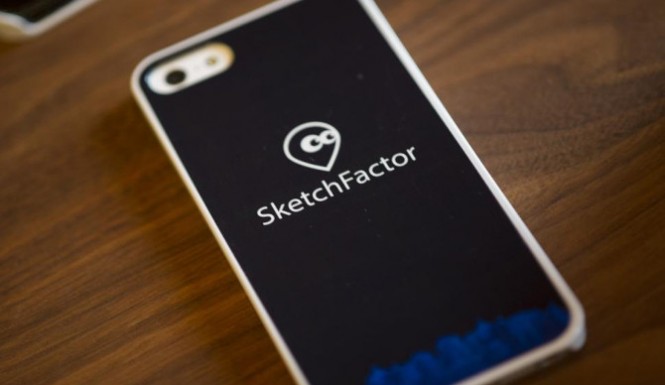Is Your Smartphone Racist? “SketchFactor” Targets Ypsilanti
Want to avoid black people in Washtenaw County? There’s an app for that now.
by Ryan Hunter
WANT TO FIND the nearest Whole Foods? There’s an app for that. Want to know when your favorite movie is playing next? There’s an app for that. Want to avoid black people and “ghetto” neighborhoods? Apparently, there is an app for that now, as well. With the expansion of the Smartphone marketplace, app designers have the opportunity to become industry superstars.
According to the most recent mobile phone forecast from the International Data Corporation (IDC) Worldwide Quarterly Mobile Phone Tracker, more than 1.25 billion smartphones were projected to be shipped worldwide in 2014, representing a 23.8 percent increase from the 1.01 billion units shipped in 2013.
“Looking ahead, total volumes are forecast to reach 1.8 billion units in 2018, resulting in a 12.7 percent compound annual growth rate (CAGR) for the 2013 – 2018 forecast period,” according to a recent IDC report.
This means that app developers and programmers are hard at work coding what they hope will be the next social media sensation, such as Tinder, or Snapchat. Should an app catch on, riches can follow. Zynga, the app company that brought us “Word With Friends,” earned $870 million in 2013. App development is akin to the era of the Wild West. Developers adhere to their own rules and decidedly not politically correct mores.
The apps “Avoid Ghetto” and “SketchFactor” are two that have raised eyebrows.
Developed by two young, white people, Allison McGuire and Daniel Herrington, “SketchFactor” was designed to help its users avoid neighborhoods with higher crime-rates, or “unsafe elements.”
According to an August 2014 piece published in Crain’s, “SketchFactor…is a navigation app that crowdsources user experiences along with publicly available data to rate the relative ‘sketchiness’ of certain areas in major cities. According to Ms. McGuire, a Los Angeles native who lives in the West Village, the impetus behind SketchFactor was her experience as a young woman navigating the streets of Washington, D.C., where she worked at a nonprofit.”
SketchFactor rates neighborhoods exclusively through user input, so anyone using the app has the ability to dictate which neighborhoods should be avoided. According to technology analysts and app reviewers, however, the app is aimed at determining where minorities live, as opposed to where crime is actually rampant.
A local test run of the app—one swipe through Washtenaw County—and users are immediately told to stay away from Ypsilanti completely; not parts of Ypsilanti, but the entire city.
SketchFactor users who recommended to others that Ypsilanti be avoided often remarked upon unsubstantiated claims of prostitution, illegal drug usage, and restaurants where there are too many blacks and Latinos.
Neighboring cities Ann Arbor, Saline, and Dexter don’t even rate on SketchFactor despite the fact that these cities have had highly publicized violent sexual assaults, break-ins, and drug busts. Ypsilanti, according to data from the U.S. Census Bureau, has more racial diversity—a higher percentage of black and Latino residents.
Critics of SketchFactor have targeted as the app’s main flaw it’s unregulated and unverified data supplied by users.
This has triggered questions about the creation and use of such apps.

SketchFactor creator Allison McGuire denies that the app was intended to create a racially-targeted map of any city. McGuire has maintained that she wanted to avoid dangerous areas. However, despite her best neighborhood-watch efforts, critics say users have turned this tool into a race-based means of discrimination.
When using the app to search through user evaluations of the safety of major metropolitan areas, user comments quickly descend into foul-mouthed, racist tirades.
Though SketchFactor says prejudiced/racist comments will be deleted, the app also goes on to say in the fine-print that comments meant to be “funny” will remain, because humor is, after all, subjective. This has created a grey-zone that means hate speech can go unmoderated.
Critics of the apps say this type of negative racial stereotyping helps foster racial insensitivities.
Racial profiling remains a problem in Washtenaw County and the country, as the tension between minorities and police grows.
SketchFactor’s critics say the app is dangerous.
“It’s hard to even find words to describe how I feel about this app,” Amalia Deloney, the associate director of the Center for Media Justice told the Washington Post in August 2014. “It’s atrocious. It’s getting into really dangerous territory. And I think it represents everything that’s wrong with technology: making it not for the many, but for the privileged few.”
You can only use SketchFactor if you have an iPhone, which — as Deloney told the Washington Post — few low-income people do.
According to a 2013 study by the Pew Research Center, in the U.S., 56 percent of Americans own a smartphone. Only 43 percent of Americans who earn less than $30,000 per year own SmartPhones.
Amalia Deloney isn’t the only critic who says apps such as these should be avoided because they aren’t based upon hard data, but on personal perception.
The Atlantic’s CityLab blog characterized SketchFactor as “Another tone-deaf neighborhood innovation. Let’s call them poortals: apps designed to help the privileged avoid the poor.” Atlantic writer Kristin Capps goes on to write, “Instead, the app fuels (and is fueled by) a paranoid style of navigation, one in which crimes of opportunity lurk in surroundings that (white, well-to-do) people deem as unfamiliar or disorderly. It’s similar in philosophy to a popular approach to policing, one that recent research has demonstrated to be both biased and ineffective.”



